University Engineering Science Part 1: Ship Building Project Report
VerifiedAdded on 2023/06/10
|7
|1881
|258
Report
AI Summary
This report delves into the engineering science behind ship construction, focusing on the materials used and the principles governing their application. It begins with an introduction to ship components and the common materials employed, such as steel, iron, aluminum, and plastics. The report then explores the properties of these materials, particularly steel, discussing its metallurgical characteristics, tensile strength, and the effects of alloy elements. It examines Archimedes' principle, explaining buoyancy and its role in ship design, including the factors affecting a ship's load-bearing capacity and passenger capacity. Further analysis compares the elasticity and breaking points of materials like steel and iron to determine their suitability for shipbuilding. D'Alembert's principle is then applied to estimate the energy requirements of a ship. The report concludes by discussing the impact of temperature variations on ship materials and the resulting design considerations. The report provides insights into the practical application of engineering principles in the maritime industry.
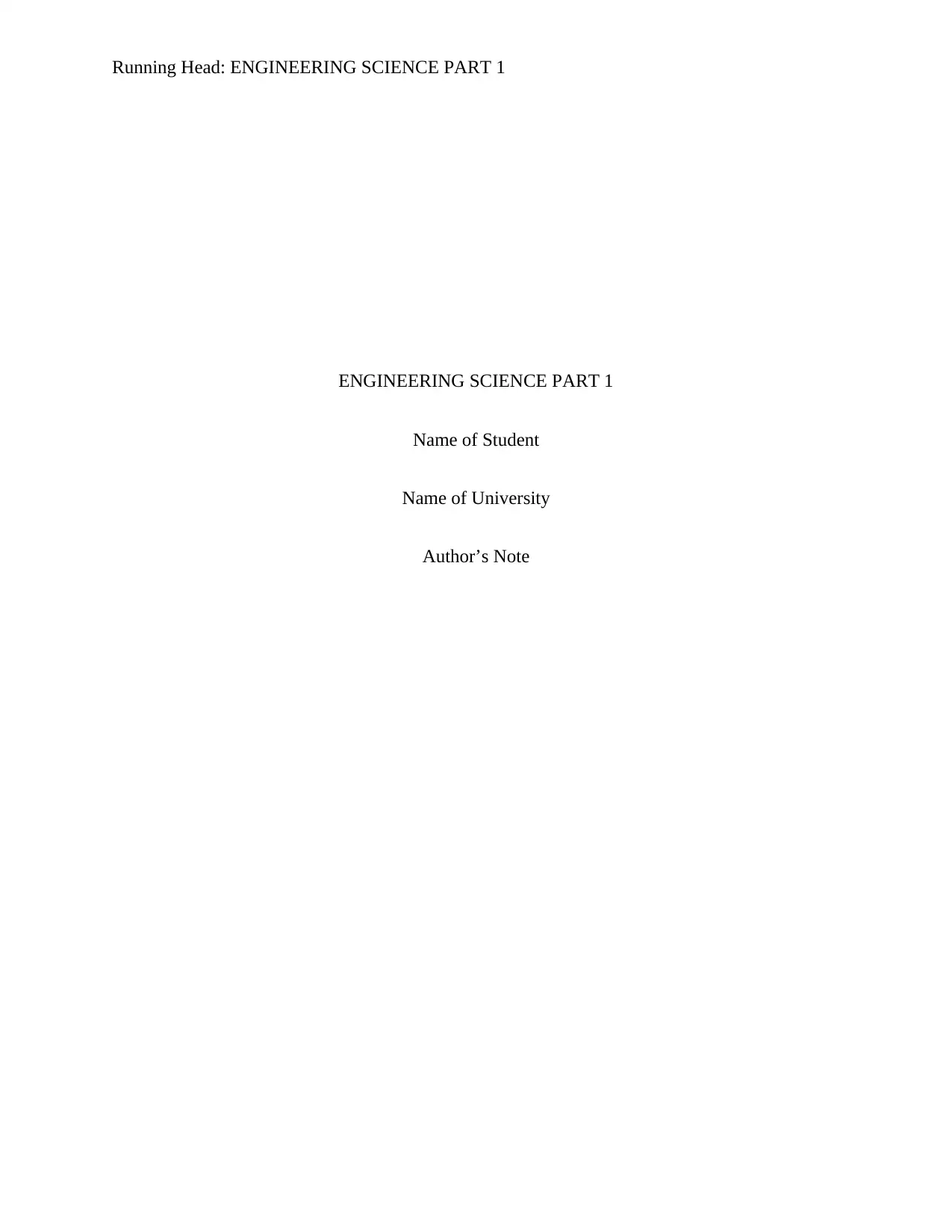
Running Head: ENGINEERING SCIENCE PART 1
ENGINEERING SCIENCE PART 1
Name of Student
Name of University
Author’s Note
ENGINEERING SCIENCE PART 1
Name of Student
Name of University
Author’s Note
Paraphrase This Document
Need a fresh take? Get an instant paraphrase of this document with our AI Paraphraser

1ENGINEERING SCIENCE PART 1
Introduction:
Ships require some basic components that are required to build them. Most of the ships
need almost similar materials to build. The materials required in order to build a ship include
iron, aluminum, steel, plastics and many more, but the materials are not just limited to these.
There are numerous more materials that are needed for specifically building a ship (DeVellis
2016). This report provides a project plan which represents various factors that should be
considered while building a ship. This report further discusses regarding various factors that are
needed to check in order to build a ship that would perform more efficiently.
Discussion:
The ability of metal and non-metal materials that are used in building ships. There are numerous
materials that are used in building ship, including ferrous metals as well as non-ferrous metals,
GRP (Grass Reinforced Plastics/fiber glass), wood and plastics. Steel is the material that is
widely used in projects of shipbuilding. Steel has very good metallurgical properties which helps
it to overcome fatigue and brittle fracture. Steel that consists very low carbon has tensile strength
of around 400 to 490 MN/m2 and yields strength of around 235 MN/m2 (Cullen 2018). It
elongates around 15 to 20%. Steel can be treated with heat. Alloy elements can be used to
change various characteristics of steel. Carbon can be used to increase hardness as well as
strength, it also reduced ductility. Manganese increases the tensile strength, notch toughness and
ductility. Silicon is used to increase tensile strength and hardness, it makes welding very easy
(Casareale, Bernardini and Bartolucci 2017). Sulphur makes welding easy and reduces the
complexity in weldability. Phosphorous improves the level of ductility and toughness.
Introduction:
Ships require some basic components that are required to build them. Most of the ships
need almost similar materials to build. The materials required in order to build a ship include
iron, aluminum, steel, plastics and many more, but the materials are not just limited to these.
There are numerous more materials that are needed for specifically building a ship (DeVellis
2016). This report provides a project plan which represents various factors that should be
considered while building a ship. This report further discusses regarding various factors that are
needed to check in order to build a ship that would perform more efficiently.
Discussion:
The ability of metal and non-metal materials that are used in building ships. There are numerous
materials that are used in building ship, including ferrous metals as well as non-ferrous metals,
GRP (Grass Reinforced Plastics/fiber glass), wood and plastics. Steel is the material that is
widely used in projects of shipbuilding. Steel has very good metallurgical properties which helps
it to overcome fatigue and brittle fracture. Steel that consists very low carbon has tensile strength
of around 400 to 490 MN/m2 and yields strength of around 235 MN/m2 (Cullen 2018). It
elongates around 15 to 20%. Steel can be treated with heat. Alloy elements can be used to
change various characteristics of steel. Carbon can be used to increase hardness as well as
strength, it also reduced ductility. Manganese increases the tensile strength, notch toughness and
ductility. Silicon is used to increase tensile strength and hardness, it makes welding very easy
(Casareale, Bernardini and Bartolucci 2017). Sulphur makes welding easy and reduces the
complexity in weldability. Phosphorous improves the level of ductility and toughness.
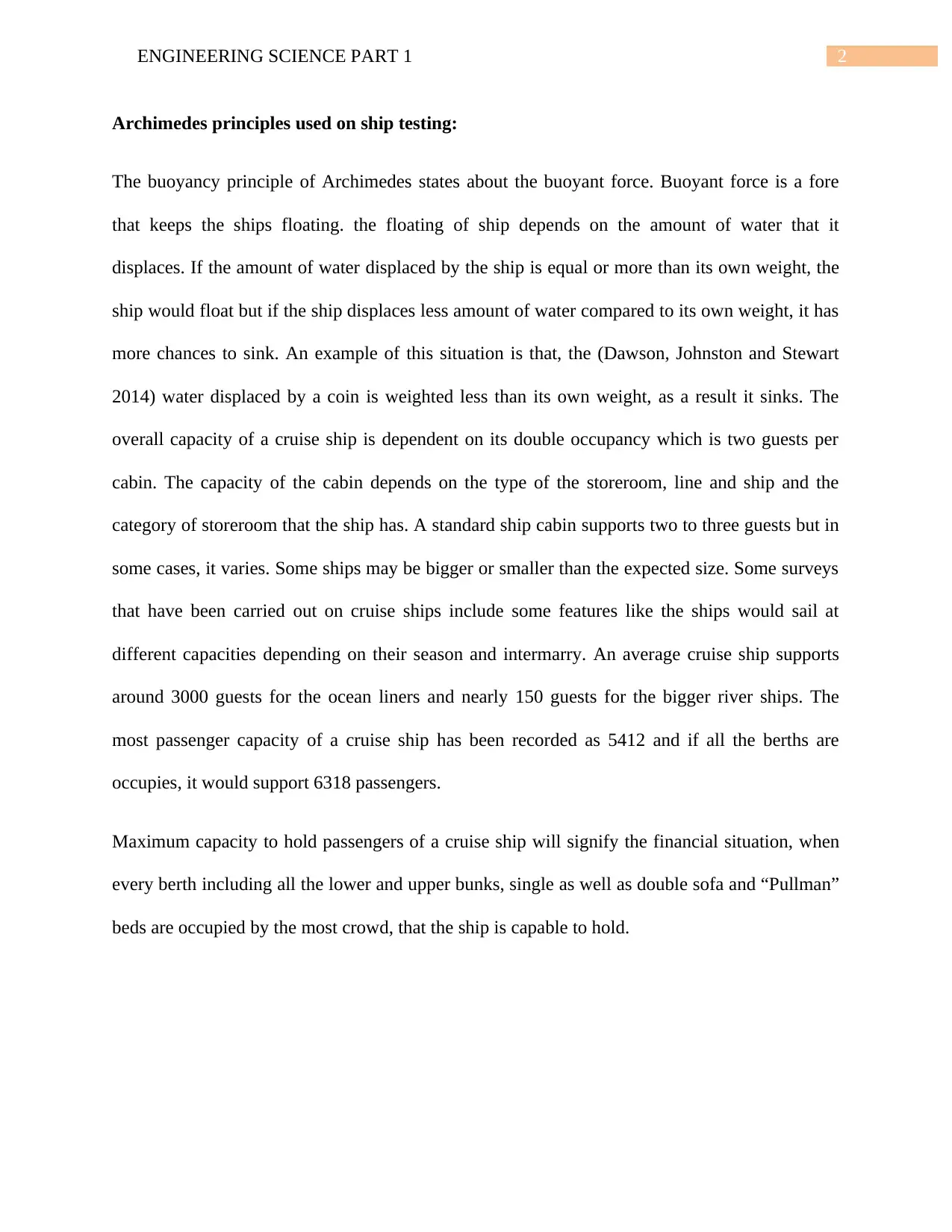
2ENGINEERING SCIENCE PART 1
Archimedes principles used on ship testing:
The buoyancy principle of Archimedes states about the buoyant force. Buoyant force is a fore
that keeps the ships floating. the floating of ship depends on the amount of water that it
displaces. If the amount of water displaced by the ship is equal or more than its own weight, the
ship would float but if the ship displaces less amount of water compared to its own weight, it has
more chances to sink. An example of this situation is that, the (Dawson, Johnston and Stewart
2014) water displaced by a coin is weighted less than its own weight, as a result it sinks. The
overall capacity of a cruise ship is dependent on its double occupancy which is two guests per
cabin. The capacity of the cabin depends on the type of the storeroom, line and ship and the
category of storeroom that the ship has. A standard ship cabin supports two to three guests but in
some cases, it varies. Some ships may be bigger or smaller than the expected size. Some surveys
that have been carried out on cruise ships include some features like the ships would sail at
different capacities depending on their season and intermarry. An average cruise ship supports
around 3000 guests for the ocean liners and nearly 150 guests for the bigger river ships. The
most passenger capacity of a cruise ship has been recorded as 5412 and if all the berths are
occupies, it would support 6318 passengers.
Maximum capacity to hold passengers of a cruise ship will signify the financial situation, when
every berth including all the lower and upper bunks, single as well as double sofa and “Pullman”
beds are occupied by the most crowd, that the ship is capable to hold.
Archimedes principles used on ship testing:
The buoyancy principle of Archimedes states about the buoyant force. Buoyant force is a fore
that keeps the ships floating. the floating of ship depends on the amount of water that it
displaces. If the amount of water displaced by the ship is equal or more than its own weight, the
ship would float but if the ship displaces less amount of water compared to its own weight, it has
more chances to sink. An example of this situation is that, the (Dawson, Johnston and Stewart
2014) water displaced by a coin is weighted less than its own weight, as a result it sinks. The
overall capacity of a cruise ship is dependent on its double occupancy which is two guests per
cabin. The capacity of the cabin depends on the type of the storeroom, line and ship and the
category of storeroom that the ship has. A standard ship cabin supports two to three guests but in
some cases, it varies. Some ships may be bigger or smaller than the expected size. Some surveys
that have been carried out on cruise ships include some features like the ships would sail at
different capacities depending on their season and intermarry. An average cruise ship supports
around 3000 guests for the ocean liners and nearly 150 guests for the bigger river ships. The
most passenger capacity of a cruise ship has been recorded as 5412 and if all the berths are
occupies, it would support 6318 passengers.
Maximum capacity to hold passengers of a cruise ship will signify the financial situation, when
every berth including all the lower and upper bunks, single as well as double sofa and “Pullman”
beds are occupied by the most crowd, that the ship is capable to hold.
⊘ This is a preview!⊘
Do you want full access?
Subscribe today to unlock all pages.

Trusted by 1+ million students worldwide

3ENGINEERING SCIENCE PART 1
Comparing the elasticity and breaking point of materials and choose the most suitable
materials:
Elasticity of an object is the ability of an object to come back to its original size when a force is
applied to it and its shape has been changed. This can be expressed by using the ratio of stress
that has been applied per Square pascals or inch to the strain. Iron can be defined as a basic
element but is available at various grades, steel is available in numerous allowed chemistry’s
(Gibson, Lim and Holmes 2016). At a particular room temperature, the elastic modules of
various iron grades ranges from 10 – 24 x 10^6 psi whereas the modulus of various steel alloys
ranges from 28 – 30 x 10^6 psi. In case the Young modulus of a metal is greater, it is stiffer. This
proves that iron is more elastic than steel. The breaking point of iron is more than compared to
steel. Hence using steel is a better option while building a ship.
D’Alembert’s principle for accessing the amount of energy needed by the ship:
Estimating the power consumed by a ship is one of the most important steps that has to
be carried out before starting the project. the power consumed by a ship is needed to be
estimated, calculated according to the optimization of the requirements of the ship. Power used
up by a ship is the major deciding factor for numerous other factors involved in the industry both
environment as well as market. According to D’Alembert’s principle a ship that has more power
requirements would consume more amount of fuel. This would result in the increased of fuel
consumption. According to the recent trends, the actual efficiency of a particular ship is
quantifies by the Energy Efficiency Design Index (EEDI). The lesser the amount of EEDI of a
particular ship, its efficiency increases. When the EEDI of the ship is proportional to the power
used by the ship, designers are suggested to decrease the requirements of power in order to run
Comparing the elasticity and breaking point of materials and choose the most suitable
materials:
Elasticity of an object is the ability of an object to come back to its original size when a force is
applied to it and its shape has been changed. This can be expressed by using the ratio of stress
that has been applied per Square pascals or inch to the strain. Iron can be defined as a basic
element but is available at various grades, steel is available in numerous allowed chemistry’s
(Gibson, Lim and Holmes 2016). At a particular room temperature, the elastic modules of
various iron grades ranges from 10 – 24 x 10^6 psi whereas the modulus of various steel alloys
ranges from 28 – 30 x 10^6 psi. In case the Young modulus of a metal is greater, it is stiffer. This
proves that iron is more elastic than steel. The breaking point of iron is more than compared to
steel. Hence using steel is a better option while building a ship.
D’Alembert’s principle for accessing the amount of energy needed by the ship:
Estimating the power consumed by a ship is one of the most important steps that has to
be carried out before starting the project. the power consumed by a ship is needed to be
estimated, calculated according to the optimization of the requirements of the ship. Power used
up by a ship is the major deciding factor for numerous other factors involved in the industry both
environment as well as market. According to D’Alembert’s principle a ship that has more power
requirements would consume more amount of fuel. This would result in the increased of fuel
consumption. According to the recent trends, the actual efficiency of a particular ship is
quantifies by the Energy Efficiency Design Index (EEDI). The lesser the amount of EEDI of a
particular ship, its efficiency increases. When the EEDI of the ship is proportional to the power
used by the ship, designers are suggested to decrease the requirements of power in order to run
Paraphrase This Document
Need a fresh take? Get an instant paraphrase of this document with our AI Paraphraser
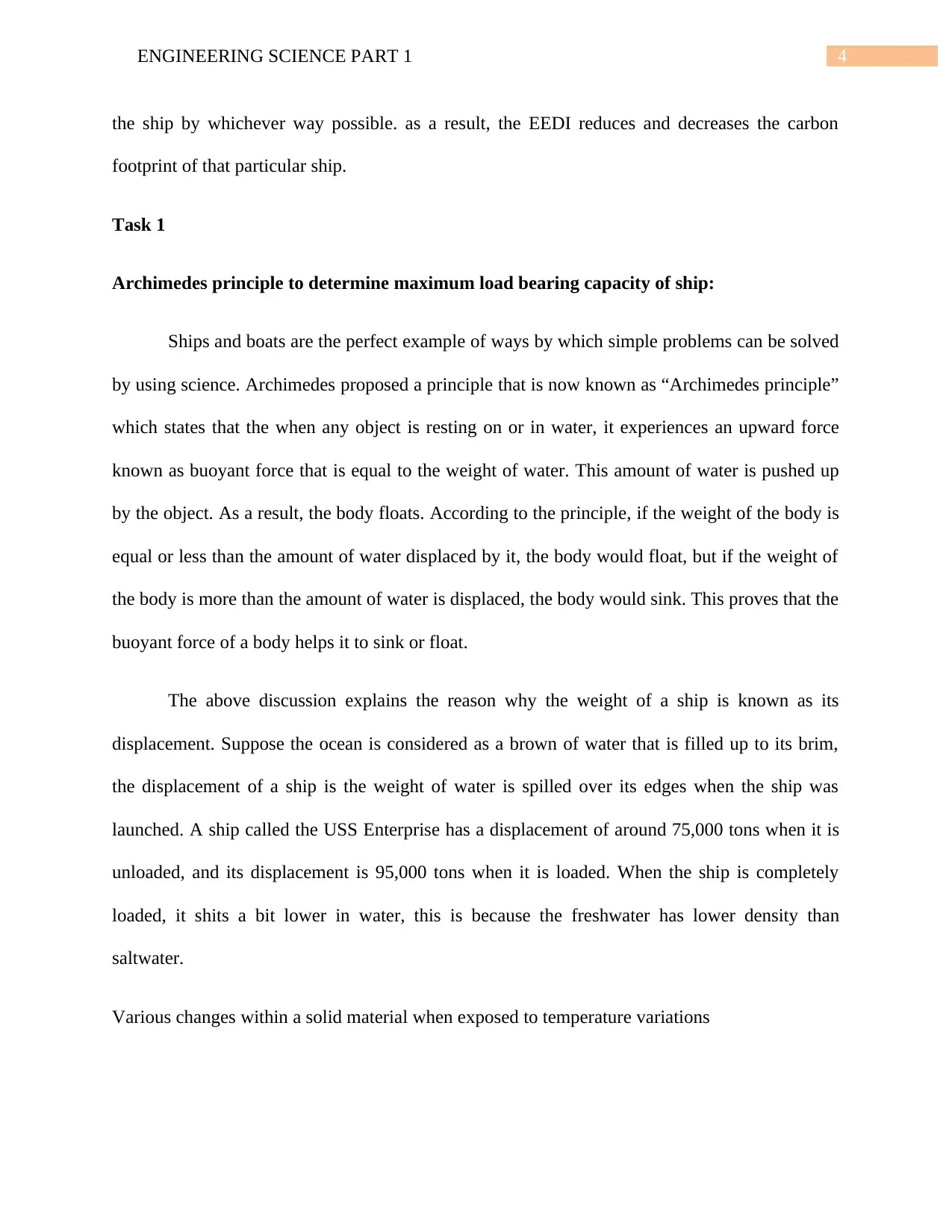
4ENGINEERING SCIENCE PART 1
the ship by whichever way possible. as a result, the EEDI reduces and decreases the carbon
footprint of that particular ship.
Task 1
Archimedes principle to determine maximum load bearing capacity of ship:
Ships and boats are the perfect example of ways by which simple problems can be solved
by using science. Archimedes proposed a principle that is now known as “Archimedes principle”
which states that the when any object is resting on or in water, it experiences an upward force
known as buoyant force that is equal to the weight of water. This amount of water is pushed up
by the object. As a result, the body floats. According to the principle, if the weight of the body is
equal or less than the amount of water displaced by it, the body would float, but if the weight of
the body is more than the amount of water is displaced, the body would sink. This proves that the
buoyant force of a body helps it to sink or float.
The above discussion explains the reason why the weight of a ship is known as its
displacement. Suppose the ocean is considered as a brown of water that is filled up to its brim,
the displacement of a ship is the weight of water is spilled over its edges when the ship was
launched. A ship called the USS Enterprise has a displacement of around 75,000 tons when it is
unloaded, and its displacement is 95,000 tons when it is loaded. When the ship is completely
loaded, it shits a bit lower in water, this is because the freshwater has lower density than
saltwater.
Various changes within a solid material when exposed to temperature variations
the ship by whichever way possible. as a result, the EEDI reduces and decreases the carbon
footprint of that particular ship.
Task 1
Archimedes principle to determine maximum load bearing capacity of ship:
Ships and boats are the perfect example of ways by which simple problems can be solved
by using science. Archimedes proposed a principle that is now known as “Archimedes principle”
which states that the when any object is resting on or in water, it experiences an upward force
known as buoyant force that is equal to the weight of water. This amount of water is pushed up
by the object. As a result, the body floats. According to the principle, if the weight of the body is
equal or less than the amount of water displaced by it, the body would float, but if the weight of
the body is more than the amount of water is displaced, the body would sink. This proves that the
buoyant force of a body helps it to sink or float.
The above discussion explains the reason why the weight of a ship is known as its
displacement. Suppose the ocean is considered as a brown of water that is filled up to its brim,
the displacement of a ship is the weight of water is spilled over its edges when the ship was
launched. A ship called the USS Enterprise has a displacement of around 75,000 tons when it is
unloaded, and its displacement is 95,000 tons when it is loaded. When the ship is completely
loaded, it shits a bit lower in water, this is because the freshwater has lower density than
saltwater.
Various changes within a solid material when exposed to temperature variations
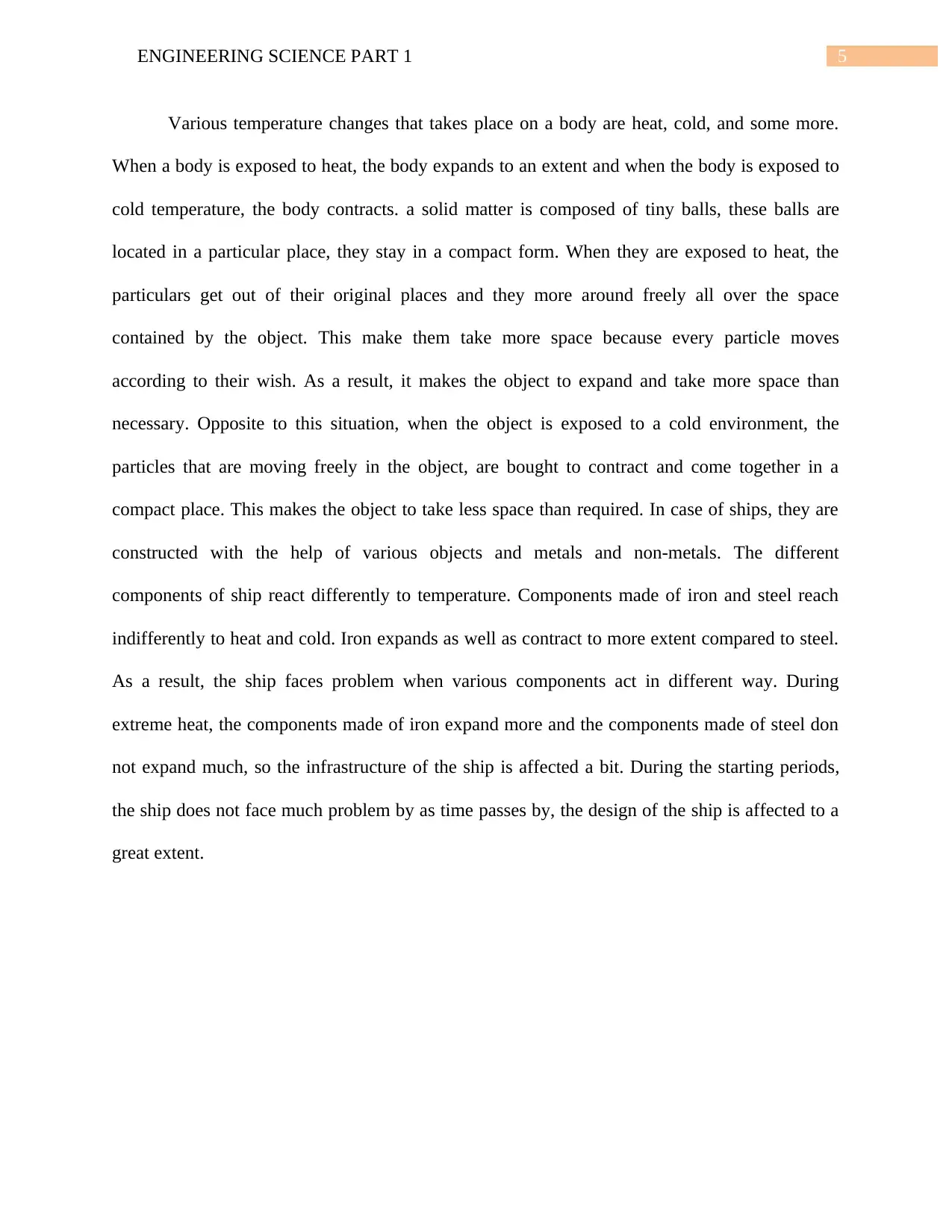
5ENGINEERING SCIENCE PART 1
Various temperature changes that takes place on a body are heat, cold, and some more.
When a body is exposed to heat, the body expands to an extent and when the body is exposed to
cold temperature, the body contracts. a solid matter is composed of tiny balls, these balls are
located in a particular place, they stay in a compact form. When they are exposed to heat, the
particulars get out of their original places and they more around freely all over the space
contained by the object. This make them take more space because every particle moves
according to their wish. As a result, it makes the object to expand and take more space than
necessary. Opposite to this situation, when the object is exposed to a cold environment, the
particles that are moving freely in the object, are bought to contract and come together in a
compact place. This makes the object to take less space than required. In case of ships, they are
constructed with the help of various objects and metals and non-metals. The different
components of ship react differently to temperature. Components made of iron and steel reach
indifferently to heat and cold. Iron expands as well as contract to more extent compared to steel.
As a result, the ship faces problem when various components act in different way. During
extreme heat, the components made of iron expand more and the components made of steel don
not expand much, so the infrastructure of the ship is affected a bit. During the starting periods,
the ship does not face much problem by as time passes by, the design of the ship is affected to a
great extent.
Various temperature changes that takes place on a body are heat, cold, and some more.
When a body is exposed to heat, the body expands to an extent and when the body is exposed to
cold temperature, the body contracts. a solid matter is composed of tiny balls, these balls are
located in a particular place, they stay in a compact form. When they are exposed to heat, the
particulars get out of their original places and they more around freely all over the space
contained by the object. This make them take more space because every particle moves
according to their wish. As a result, it makes the object to expand and take more space than
necessary. Opposite to this situation, when the object is exposed to a cold environment, the
particles that are moving freely in the object, are bought to contract and come together in a
compact place. This makes the object to take less space than required. In case of ships, they are
constructed with the help of various objects and metals and non-metals. The different
components of ship react differently to temperature. Components made of iron and steel reach
indifferently to heat and cold. Iron expands as well as contract to more extent compared to steel.
As a result, the ship faces problem when various components act in different way. During
extreme heat, the components made of iron expand more and the components made of steel don
not expand much, so the infrastructure of the ship is affected a bit. During the starting periods,
the ship does not face much problem by as time passes by, the design of the ship is affected to a
great extent.
⊘ This is a preview!⊘
Do you want full access?
Subscribe today to unlock all pages.

Trusted by 1+ million students worldwide
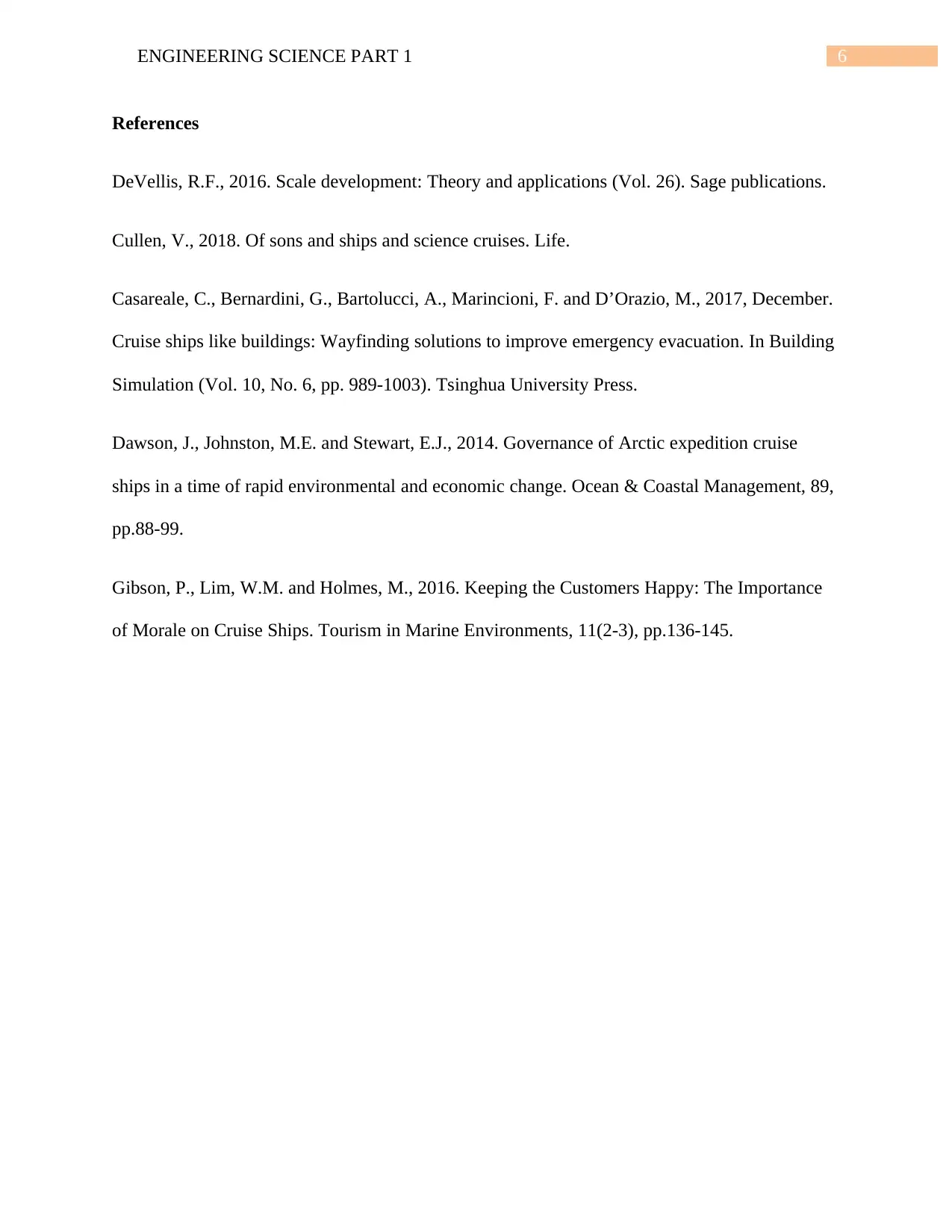
6ENGINEERING SCIENCE PART 1
References
DeVellis, R.F., 2016. Scale development: Theory and applications (Vol. 26). Sage publications.
Cullen, V., 2018. Of sons and ships and science cruises. Life.
Casareale, C., Bernardini, G., Bartolucci, A., Marincioni, F. and D’Orazio, M., 2017, December.
Cruise ships like buildings: Wayfinding solutions to improve emergency evacuation. In Building
Simulation (Vol. 10, No. 6, pp. 989-1003). Tsinghua University Press.
Dawson, J., Johnston, M.E. and Stewart, E.J., 2014. Governance of Arctic expedition cruise
ships in a time of rapid environmental and economic change. Ocean & Coastal Management, 89,
pp.88-99.
Gibson, P., Lim, W.M. and Holmes, M., 2016. Keeping the Customers Happy: The Importance
of Morale on Cruise Ships. Tourism in Marine Environments, 11(2-3), pp.136-145.
References
DeVellis, R.F., 2016. Scale development: Theory and applications (Vol. 26). Sage publications.
Cullen, V., 2018. Of sons and ships and science cruises. Life.
Casareale, C., Bernardini, G., Bartolucci, A., Marincioni, F. and D’Orazio, M., 2017, December.
Cruise ships like buildings: Wayfinding solutions to improve emergency evacuation. In Building
Simulation (Vol. 10, No. 6, pp. 989-1003). Tsinghua University Press.
Dawson, J., Johnston, M.E. and Stewart, E.J., 2014. Governance of Arctic expedition cruise
ships in a time of rapid environmental and economic change. Ocean & Coastal Management, 89,
pp.88-99.
Gibson, P., Lim, W.M. and Holmes, M., 2016. Keeping the Customers Happy: The Importance
of Morale on Cruise Ships. Tourism in Marine Environments, 11(2-3), pp.136-145.
1 out of 7
Your All-in-One AI-Powered Toolkit for Academic Success.
+13062052269
info@desklib.com
Available 24*7 on WhatsApp / Email
![[object Object]](/_next/static/media/star-bottom.7253800d.svg)
Unlock your academic potential
Copyright © 2020–2025 A2Z Services. All Rights Reserved. Developed and managed by ZUCOL.


